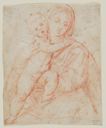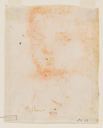Artist: Pomponio Amalteo (Italian, 1505-1588)
Medium: red chalk on paper
Dimensions: 5 3/16 in. x 4 1/4 in. (13.2 cm. x 10.8 cm.)
Credit Line: Bequest of the Honorable James Bowdoin III
Accession Number: 1811.33
- "Purdeno"
Type: inscription
Location: verso
Materials: pen and brown ink - "Titian"
Type: inscription
Location: verso of former mount (lost)
Materials: pen and ink - Amsterdam Art Dealer, Auctioneer & Collector, Jan Pietersz. Zomer, died in 1724,
(Lugt 1511)
Type: collector's mark
Location:
Materials:
- Jan Pietersz. Zomer(
Dealer and Collector,
)
-
.
(1641-1724) - James Bowdoin III( Collector, Boston) - 1811.
- Bowdoin College Museum of Art( Museum, Brunswick, Maine) 1811- . Bequest
- Old Master Drawings at Bowdoin College
- Bowdoin College Museum of Art. ( 5/17/1985 - 7/7/1985)
- Clark Art Institute. ( 9/14/1985 - 10/27/1985)
- University of Kansas. ( 1/19/1986 - 3/2/1986)
- Art Gallery of Ontario. ( 5/17/1986 - 6/29/1986)
- Modernism and the Nude
- Bowdoin College Museum of Art. ( 11/13/2001 - 1/13/2002)
Type: exhibition catalogue Author: David P. Becker Document Title: Old Master Drawings at Bowdoin College Publ. Place: Brunswick, Maine Location: pp. 76-77 Reference: no. 34 (illus.) Publisher: Bowdoin College Date: 1985
The verso inscription on the drawing reflects an early attribution to Pordenone, but the work came to the collections mounted with an optimistic upgrading to Titian. Frank Jewett Mather, Jr. placed it in the seventeenth century, but it was subsequently ascribed to Giovanni Francesco Caroto (1480–1555/8), a Veronese painter, by an unknown scholar (Mather, 248). It was first recognized by W. R. Rearick as a study by Amalteo, and this attribution has been accepted by Charles Cohen. The latter cites a comparable red chalk sketch of the Holy Family by Amalteo in the Uffizi; he places that sheet earlier than Bowdoin's because of its less skillful rendering of anatomy (Cohen 1973, 239-40). Cohen dates the Uffizi sketch to the early 1530s. He points out the facial and figural style of the Bowdoin drawing as being typical of Amalteo's style, to which can be added the characteristic "chunkiness" of the figures, particularly the Christ Child (Cohen 1980, 76). The verso, a red chalk drawing of a child’s head, is likely an offset from another drawing, probably from the next sheet in a sketchbook.
The Bowdoin drawing does not correspond precisely to any known painting by Amalteo, but the Madonna and Child in similar poses and with similar expressions are included in several altarpieces and fresco cycles. The earliest is from the cycle of saints and sibyls at San Giovanni in Gemona from 1533 (fig. 1), followed by the Virgin and Child with Sts. Stephen and John the Baptist in Santo Stefano at Cesclans from 1537 (fig. 2) and the Mystic Marriage of St. Catherine, also of 1537, from Santa Caterina in Tolmezzo (fig. 3). Later paintings with a similar motif include The Holy Father, the Virgin and Child, St. Domenic, and St. Francis from 1556 in the cathedral in Motta di Livenza (fig. 4), the Flight into Egypt of 1565 in Pordenone Cathedral (fig. 5), and the badly damaged fresco of the Virgin and Child with Saints of 1569 in the parochial church of Osoppo (fig. 6).
The collector’s stamp on the verso indicates that the drawing was in the collection of Jan Pietersz. Zomer (1641–1724), a Dutch engraver, art collector, and dealer active in Amsterdam. Another Bowdoin drawing, 1811.46, attributed to an Italian artist working in the mid-sixteenth century, has the same stamp. Zomer’s collection was dispersed after his death and many sheets traveled across Europe. It is possible that John Smibert bought the two sheets before leaving for Boston or they could have been purchased by James Bowdoin III on one of his many trips to London or in Paris.
David P. Becker (edited by Sarah Cantor)
References:
Cohen, Charles E. “Drawings by Pomponio Amalteo.” Master Drawings 11, no. 3 (Autumn 1973): 239-67 and 299-317.
Cohen, Charles E. “Considerazioni e proposte sui disegni di Pomponio Amalteo.” In Amalteo, edited by Luigi Menegazzi, 71-92. Pordenone: Grafiche Editioriali Artistiche Pordenonesi, 1980.
Mather, Jr., Frank Jewett. “Drawings by Old Masters at Bowdoin College.” Art in America 1, no. 1 (January 1913): 244-53.
Images:
Fig. 1: Pomponio Amalteo Virgin and Child, 1533, San Giovanni, Gemona
Fig. 2: Pomponio Amalteo Virgin and Child with Sts. Stephen and John the Baptist, 1537, Santo Stefano, Cesclans
Fig. 3: Pomponio Amalteo Mystic Marriage of St. Catherine, 1537, Santa Caterina, Tolmezzo
Fig. 4: Pomponio Amalteo The Holy Father, the Virgin and Child, St. Domenic, and St. Francis, 1556, Cathedral of Motta di Livenza
Fig. 5: Pomponio Amalteo Flight into Egypt, 1565, Cathedral of Pordenone
Fig. 6: Pomponio Amalteo Virgin and Child with Saints, 1569, Chiesa parrocchiale, Osoppo
Artist Biography:
Pomponio Amalteo was the principal student and closest follower of Giovanni Antonio da Pordenone (1484-1539). He may have inherited a number of commissions from Pordenone after the elder artist began working primarily in Venice in the 1530s. Amalteo had a very long career, which he spent entirely in the provincial area north of Venice known as the Friuli. His work consists largely of altarpieces for the parish churches and cathedrals of the region. As his style often followed that of his master, Amalteo's drawings have frequently been confused with those of Pordenone.
David P. Becker
Further Reading:
Truant, Giuseppe. Pomponio Amalteo e le sue opere. Pordenone: Grafiche Editoriali Artistiche Pordenonesi, 1980.
Furlan, Caterina and Paolo Casadio. Pomponio Amalteo: Pictor Sancti Viti 1505-1588. Milan: Skira, 2006
Commentary credited to David P. Becker (or not otherwise captioned) appeared in his catalogue Old Master Drawings at Bowdoin College (Brunswick: Bowdoin College Museum of Art, 1985).


 Museum of Art
Museum of Art
